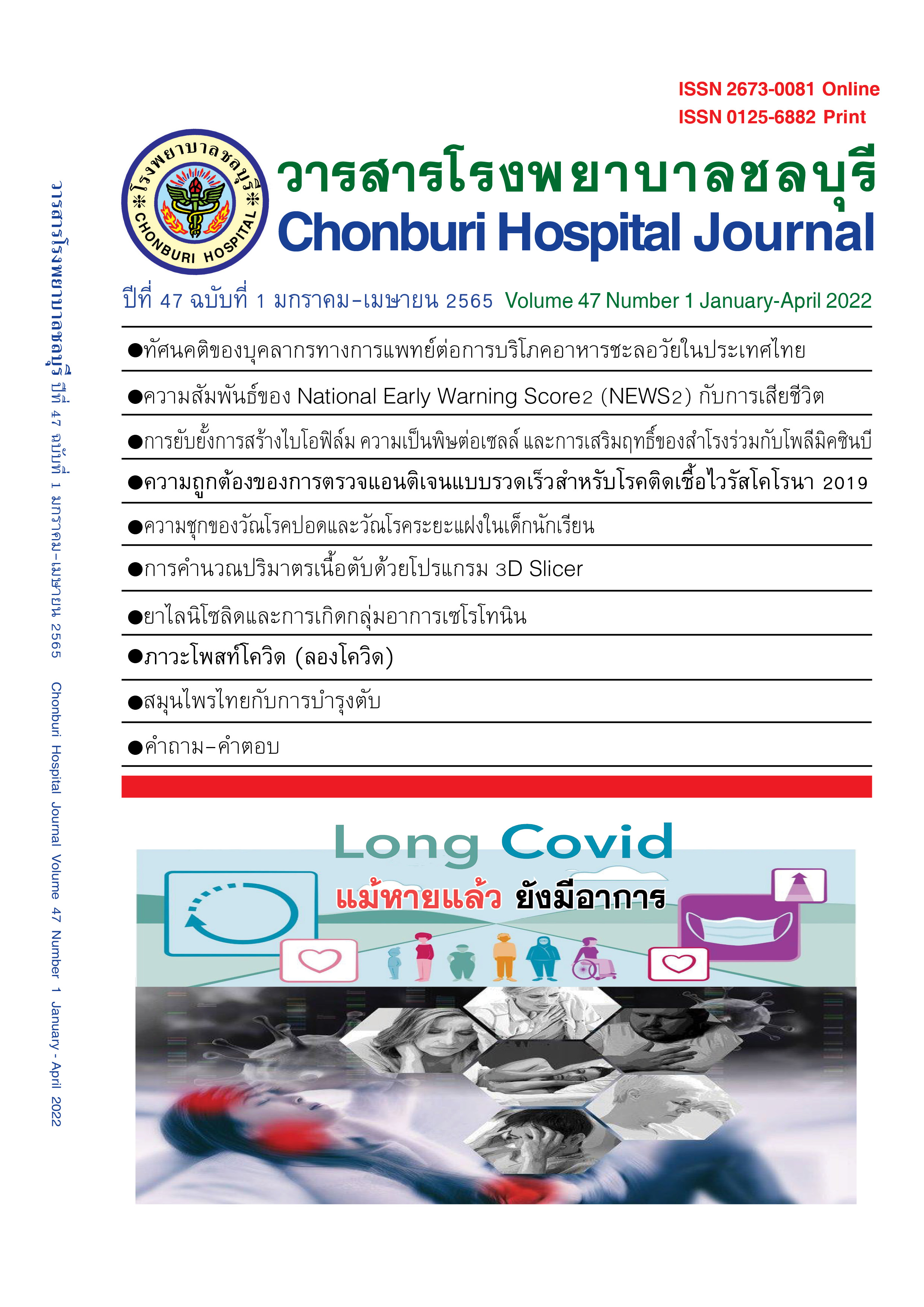The Healthcare Professionals' Attitudes Toward Anti-aging Food Consumption for Treatment in Thailand
บทคัดย่อ
การเสื่อมของร่างกายเป็นการเปลี่ยนแปลงที่เกิดขึ้นอย่างต่อเนื่องตลอดช่วงชีวิตของคน การเสื่อมหรือถดถอยลงของสมรรถภาพทางร่างกายนั้นเกิดจากปัจจัยหลายด้าน จากการศึกษาพบว่าอนุมูลอิสระนั้นมีผลที่ทำให้เซลล์และเนื้อเยื่อต่างๆในร่างกายเกิดความเสียหาย ซึ่งการเสียหายดังกล่าวนำไปสู่ภาวะของการเสื่อมร่างกาย และการบริโภคอาหารที่ได้รับการควบคุมอย่างถูกต้องจะช่วยลดการเสื่อมสมรรถภาพของร่างกายได้ งานวิจัยนี้มีวัตถุประสงค์เพื่อศึกษาอิทธิพลของความตื่นตัวเรื่องสุขภาพ การรับรู้ความเสี่ยง การรับรู้ประโยชน์ ทัศนคติเชิงพฤติกรรม และการรับรู้ความสามารถในการควบคุมพฤติกรรม ของบุคลากรทางการแพทย์ในเรื่องการบริโภคอาหารชะลอวัย ผลการวิจัยพบว่า ความตื่นตัวเรื่องสุขภาพ การรับรู้ความเสี่ยง การรับรู้ประโยชน์ และทัศนคติเชิงพฤติกรรมนั้นมีอิทธิพลในเชิงบวกต่อการรับรู้ความสามารถของบุคลากรทางการแพทย์ในการให้คำแนะนำการบริโภคอาหารชะลอวัยเพื่อควบคุมพฤติกรรมการบริโภคอาหารต่อผู้รับบริการ บุคลากรทางการแพทย์ที่มีความเชื่อมั่นในตนเองในเรื่องของการให้คําแนะนําเรื่องการบริโภคอาหารชะลอวัยนั้น จะทำให้ผู้รับบริการนำคำแนะนำที่ได้รับไปปรับเปลี่ยนพฤติการบริโภคอาหารเพื่อให้เกิดการชะลอวัยได้อย่างมีประสิทธิภาพยิ่งขึ้น นอกจากนี้งานวิจัยฉบับนี้จะช่วยในการต่อยอดองค์ความรู้ในด้านการพัฒนาบุคลากรทางการแพทย์ของศาสตร์การบริโภคอาหารชะลอวัย
เอกสารอ้างอิง
Gladyshev VN. Aging: progressive decline in fitness due to the rising deleteriome adjusted by genetic environmental, and stochastic processes. Aging Cell 2016;15(4):594–602.
Raty JV, Zhang W, Luckas J, Chen C, Mazzarello R, Bichara C, Wuttig M. Aging mechanisms in amorphous phase-change materials. Natural Communication 2015;6:7467.
Olivieri F, Albertini MC, Orciani M, Ceka A, Cricca M, Procopio AD, et al. DNA damage response (DDR) and senescence: shuttled inflamma-miRNAs on the stage of inflamm-aging. Oncotarget 2015;6(34):35509-21.
Kehrer JP, Klotz L. Free radicals and related reactive species as mediators of tissue injury and disease: implications for health. Critical Reviews in Toxicology 2015;45(9):765-98.
López-Otín C, Blasco MA, Partridge L, Serrano M, Kroemer G. The hallmarks of aging. Cell 2013;153(6):1194-217.
Su J, Ekman C, Oskolkov N, Lahti L, Ström K, Brazma A, et al. A novel atlas of gene expression in human skeletal muscle reveals molecular changes associated with aging. Skeletal Muscle 2015;5(35):1-12.
Chung HY, Sung B, Jung KJ, Zou Y, Yu BP. The molecular inflammatory process in aging. Antioxid Redox Signal 2006;8(3-4):572-81.
Masoro EJ. Caloric restriction and aging: an update. Exp Gerontol 2000;35(3):299-305.
Kumari S. Black rice: an emerging "superfood." Pantnagar Journal of Research 2020;18(1):15-8.
Yang Y, Ren C, Zhang Y, Wu X. Ginseng: an nonnegligible natural remedy for healthy aging. Aging Dis 2017;8(6):708-20.
Mastaloudis A, Wood SM. Age-related changes in cellular protection, purification, and inflammation-related gene expression: role of dietary phytonutrients. Ann N Y Acad Sci 2012;1259:112-20.
Salter A, Wiseman H, Tucker G. Phytonutrients. West Sussex: Wiley-Blackwell; 2012.
Tapsell LC, Neale EP, Satija A, Hu FB. Foods, nutrients, and dietary patterns: interconnections and implications for dietary guidelines. Adv Nutr 2016;7(3):445-54.
Bergmann BM, Gilliland MA, Feng PF, Russell DR, Shaw P, Wright M, Rechtschaffen A, Alverdy JC. Are physiological effects of sleep deprivation in the rat mediated by bacterial invasion? Sleep 1996;19(7):554-62.
Chein I, Cook SW, Harding J. The field of action research. American Psychologist 1948; 3(2):43–50.
Krech D, Crutchfield RS, Ballachey EL. Individual in society: a textbook of social psychology. NY: McGraw-Hill; 1962.
Schiffman LG, Kanuk L. Consumer behavior. NJ: Englewood Cliffs; 1994.
Gould SJ. Consumer attitudes toward health and health care: a differential perspective. Journal of Consumer Affairs 1988;22:96–118.
Newsom JT, McFarland BH, Kaplan MS, Huguet N, Zani B. The health consciousness myth: implications of the near independence of major health behaviours in the North American population. Social Science and Medicine 2005;60:433–37.
Phipps DJ, Hagger MS, Hamilton K. Predicting limiting 'free sugar' consumption using an integrated model of health behavior. Appetite 2020;150:104668.
Ajzen I. The theory of planned behavior. Organizational behavior and human decision processes 1991;50(2):179-211.
Moslehpour M, Pham VK, Wong WK, Bilgiçli İ. E-purchase intention of Taiwanese consumers: sustainable mediation of perceived usefulness and perceived ease of use. Sustainability 2018;10(1):234.
Phusiri P, Somjai S, Sriwatanaku K. Perceived usefulness, perceived risk, perceived ease of use and attitude affecting on consumer acceptance in stem cell technology in anti aging medicine. Journal of the Association of Researchers 2019;24(3):57-73.
ดาวน์โหลด
เผยแพร่แล้ว
ฉบับ
บท
การอนุญาต

This work is licensed under a Creative Commons Attribution-NonCommercial-NoDerivatives 4.0 International License.
บทความที่ได้รับการตีพิมพิ์เป็นลิขสิทธิ์ของวารสารโรงพยาบาลชลบุรี
